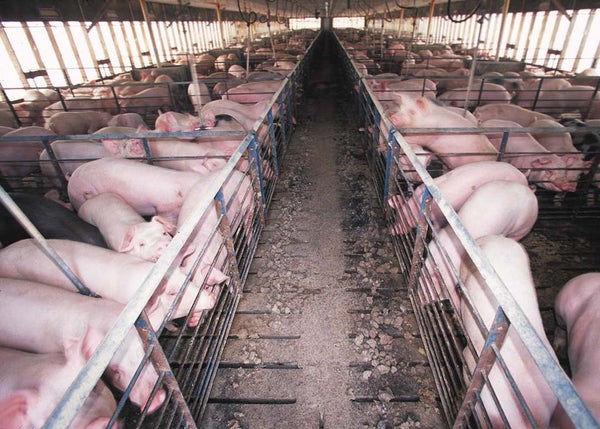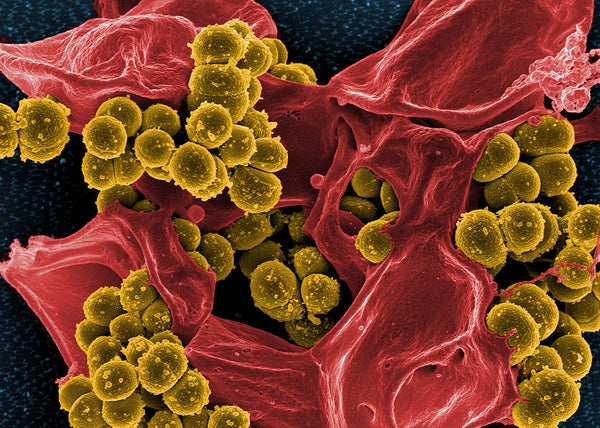This article was published in Scientific American’s former blog network and reflects the views of the author, not necessarily those of Scientific American
Welcome to the Anthropocene, the era in which one species—human beings—so utterly dominates the planet that all of the driving forces of climate, oceans, geology, air and every other life form on Earth are controlled by the activities of humanity. Most of the damage is thoughtless. Humans don’t decide to pollute, they just do so. People don’t make a choice to lower the numbers of oxygen-producing trees on the planet, they just chop them down without thinking about it.
Among the most dangerous of these thoughtless actions executed by our species is wild misuse of antibiotics. On September 21, the United Nations General Assembly is convening a special session to look at ways to curb use of precious medicinal drugs that are swiftly being outwitted by drug-resistant bacteria, making everything from a scraped knee to a bout of pneumonia far more dangerous and difficult to treat. But that focus, important as it is, remains limited to human use of chemicals and concern about their misuse to our species’ health.
Genuine governance and stewardship in the Anthropocene requires a far broader look at what our activities mean for the planet, writ large. At the most basic levels of life every single system on Earth is controlled, or influenced, by microbes—microscopic creatures ranging from nano-sized viruses to enormous colonies of bacteria; from populations of microbes in the depths of the oceans to the inside of the human gut. A human being is made up of about 30 trillion cells and 39 trillion microbes, most of which are indispensable to our mental and physical health. If all the viruses and parasites swarming inside and on the skin of a human being are tallied the microbe-to-cell ratio is about ten-to-one. The microbes—collectively known as the Human Microbiome—digest our food, help us do battle with invading pathogens, clean our skin and provide us fuel. Life without microbes is no life at all.
On supporting science journalism
If you're enjoying this article, consider supporting our award-winning journalism by subscribing. By purchasing a subscription you are helping to ensure the future of impactful stories about the discoveries and ideas shaping our world today.
Antibiotics kill bacteria, and as anybody who has been on a long course of the drugs to treat an ailment knows, the medicine is indiscriminate, knocking off not only invaders like the bugs that cause pneumonia and ear infections, but also those that prevent stomach aches and constipation in response to ingestion of food. Human overuse or misuse of antibiotics has bred the emergence of Superbugs that are not only resistant to the drugs, but may be able to surge in numbers within a person’s gut, for example, leading to dangerous imbalances in bacterial populations that then cause diabetes, some types of heart disease, depression and an enormous range of common diseases.
The Earth has its own microbiome, representing about a third of the weight of all biological material and life forms on the planet. And it is every bit as indispensable to the planet as your microbiome is to your personal health. Microbes living on the surface of the oceans, for example, aerosolize and end up in the atmosphere, where water droplets collect on their surfaces, forming clouds . Eliminating those microbes would directly affect rainfall. More oxygen that humans breathe is made by microbes than plants. And even the plants rely upon the microbiome of soil to transfer nutrients into their roots, allowing trees and forests to make more oxygen for humans to breathe.
So it should be with some considerable alarm that we consider the killing potential manmade antibiotics have for Earth’s microbiome.
When people, or our pets and livestock, take antibiotics, these substances and possible resistant bacteria are passed via sewage and septic tanks into water systems and the seas. Ton for ton, 80 percent of antibiotics are used to treat livestock, not to cure infections, but to make them fatter. Most of those chemicals, which are routinely loaded into animal feed and dumped into aquaculture systems, are chemical identical or closely similar to human treatments.
As the human population increases and wealth grows, demand for animal protein is soaring. Researchers estimate that for every 2.2 pounds of cattle weight 45 milligrams of antibiotics were used as growth promoters; for chickens that’s 148 milligrams per 2.2 pounds and for pigs it’s a whopping 172. On a global scale that translates into about 63,000 tons of antibiotics used in agriculture in 2010, which researchers predict will soar to 106,000 tons over the next 14 years. Today the United States, alone, uses 25 million pounds of antibiotic products on livestock every year.

Credit: EPA Wikimedia
Animal poop has always been a part of the environment, and played a big positive role in supplying bacteria, viruses and parasites for the Earth Microbiome. But the once-diverse range of large animals that roamed the planet has shrunk, with 92 percent of the poopers lost and the entire Earth Microbiome fertilized by just eight percent of the species that existed after the Ice Age, most of them used as livestock or pets by Homo sapiens. This means there are fewer checks-and-balances in nature to offset the monumental impact human and livestock poop are having on the Earth Microbiome.
We are filling the world with livestock and human pathogens and bacteria, many of the microbes rendered ultra-virulent or drug resistant by the barrage of antibiotics we and our animals are subjected to. For example, a super-toxic form of E.coli bacteria has thrived in the antibiotic-saturated cattle industry, and turned up killing wild deer. Wildlife all over the world, from the depths of the seas to the Himalayas, are developing antibiotic-resistant bacterial diseases. Superbugs that are resistant to nearly every antibiotic on Earth are bred, for example, in pig farms in China, flow from sewage systems or river dumps into the oceans, infecting fish. Seagulls feeding on those fish carry highly drug resistant bacteria all over the world.
Normal ocean microbes that convert sunlight into oxygen that humans breathe form microscopic vessels packed with their genes—including ones for drug resistance—that bob across the seas, to be absorbed by ocean life, even seals and whales. The dangerous organisms collect along any solid surfaces they come in contact with, forming drug resistant biofilms in which genes for resistance are swapped between microbes, even across species, making those biofilms giant lending libraries of genetic tools for devastation of the Earth Microbiome and, ultimately, human health.
Proper wastewater treatment can greatly reduce the threat to the environment, eliminating most drug-resistant organisms. But most of the world’s waste goes untreated. Worse, cheap waste treatment – the type used in most of the world—basically mixes chlorine with poop, killing off bacteria. But new research shows chlorine treatment can actually promote a surge in antibiotic-resistant microbes, in a sense purifying the waste into a form that is even more dangerous to the environment. So at a recent meeting of the American Chemical Society scientists were told that, “Treated wastewater is one of the major sources of pharmaceuticals and antibiotics in the environment. Wastewater treatment facilities were not designed to remove these drugs. The molecules are typically very stable and do not easily get biodegraded. Instead, most just pass through the treatment facility and into the aquatic environment.”
In China the overuse of antibiotics, especially in animals, and failure to remove them through standard wastewater treatment has gotten so bad that pure amoxicillin and other antibiotics come right out of the tap, into home drinking water. More than 60 different antibiotics has been found in random samples of the Yangtze and Pearl Rivers. Downstream from pharmaceutical plants in China antibiotics have been found in concentrations that are 10,000 times above normal human treatment doses. Extreme drug resistance genes have been found escaping wastewater treatment from northern China to the Rocky Mountain streams and the Hudson River alongside New York City.
Antibiotic resistant bacteria hitchhike in dust plumes, and using human cargo and transport, spreading across the terrestrial world. Birds poop them, honeybees spread them and the impact on the Earth Microbiome is enormous.
And so, as the United Nations General Assembly convenes on September 21 to debate measures aimed at preserving the utility of antibiotics to protect human health, I wish they would consider the well-being of the entire planet. We are tempting fate every time a person takes antibiotics mistakenly to treat a viral infection, a cow is fattened with pounds of “growth promoters,” a pool of salmon are dosed with antibiotics in aquaculture settings and the daily kilotons of human waste pour into the world’s rivers and seas. I wish the UN and the political leaders of the world would contemplate what killing off species of oxygen-producing microbes, of methane-eating bacteria or of human gut beneficial microbes will mean for the future of Earth.
